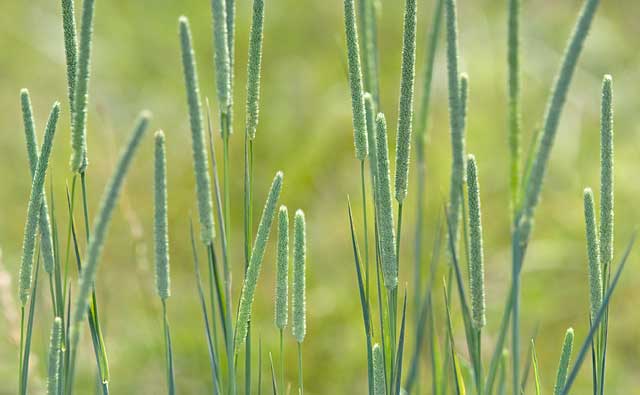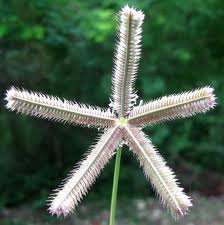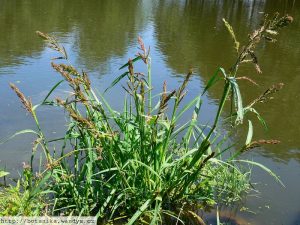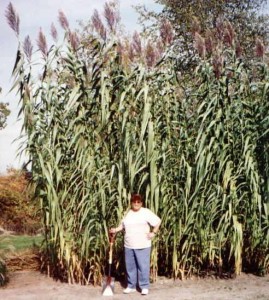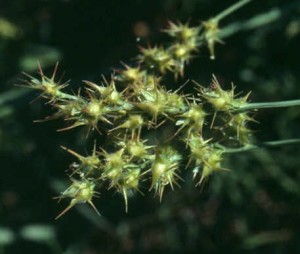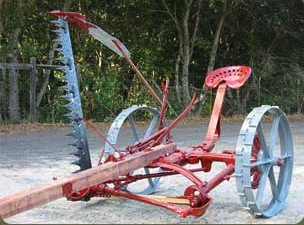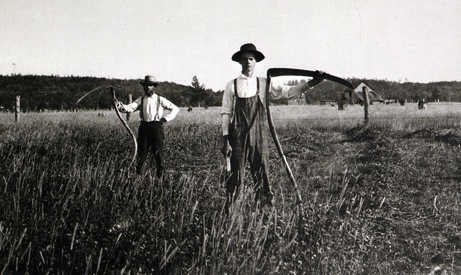That simple question has a complex answer: Yes, no, and maybe. It’s a topic I explored in a recent Green Deane Newsletter and the basis for this article.
Strictly speaking we eat a lot of grass, but in the form of grain: Wheat, rice, rye, barley, millet, sprouts et cetera. What most folks want to know is can you eat the culms and blades (stems and leaves.) What you just read — culms and blades — is one of the impediments to learning about grasses; it has an argot all its own, a specific vocabulary worse than mushrooms. More so, often with grass key identifying characteristics can only be seen with a microscope. In fact I attended a grass seminar a few months ago in which the lecturing professor said if you want guaranteed employment become a grass taxonomist. He said they are very rare and very well paid.
As for humans eating grass, we are not multi-gastric (or in theory large-gutted). We aren’t designed to break down the cellulose in grass to get out the nutriments. Cows have a four-chambered stomach for that purpose, horses have a huge large intestine, even the gorilla has a gut that can accommodate large amounts of vegetation. Humans don’t. However, what we can do is dry the grass, grind it into a powder and use it as a bulking agent in food, such as breads, soups and stews. We don’t get much nutrition from grass prepared that way but it does add to the sensation of satiety and reduces hunger. But there are even issues with that, such as how often. There is also the problem of cyanide.
I have read and been told by those with Ph.D. after their name that all North American grasses are non-toxic. Many imported grasses, however, do have cyanide in some kind of chemical bond such as with hydrogen or sugar that gets separated on digestion. At the most basic level that means one has to know if the grass is native or not which also requires identification, and I’ve already mentioned grasses are a pain in the .. ah.. grass to identify. And while “natives” might not be toxic there are many grasses that seem to have very little edible value. The Andropogons come to mind which don’t seem to have any use beyond making crude brooms. As for common toxic non-natives Johnson Grass, a sorghum, is a good bad example. The large blades can be full of cyanide, depending upon the weather. Crowfoot Grass is another. We eat the grain of Crowfoot Grass only after the plant has turned brown and the dry seeds are easily picked. Complicating the issue is that quite a few toxic grasses from Africa and Asia are naturalized in North America. Prime grain ones to look for are Sand Spurs, Barnyard Grass, and Panicums. Clover is not included here in that it is not a grass but in the pea family. Locally there is also sugar cane (non-native and native.) Sugar cane is easy to grow in warm areas but only for sugar which are empty calories but more energy than just the blades. Related native species are very fibrous and very low on sugar. Similar looking to sugar cane is Arundo donax , a controversial and wild-spread invasive in many areas of the United States. I have found only one reference to the plant’s rhizomes as edible (cooked) which makes me suspicious, and it definitely is not native, another reason to be cautious. While Arundo donax leaves and shoots are listed as edible practical experience says they are not.
And now if you will permit, let me reminisce. I recently bought another book for my foraging library, A Guide to Florida Grasses, by Walter Kingsley Taylor, not the first book in my collection from this august author. I will say more about the book in newsletters to come. I spent an afternoon browsing through the guide and noted his entry on Timothy Grass. The picture alone erased more than 50 years and took me back to summers as a boy in Maine. That’s when I was impressed into service to harvest hay for our horses, most of it Timothy, Phleum pratense, a grass originally from Europe. Because of its high protein content and low dust factor it is preferred by horses. It is also good food for small rodents like Guinea Pigs, Chinchillas, as well as rabbits. We “hayed” every summer for some 20 years usually putting ten to 15 tons of loose hay into the barn. There is some irony in that most of the hay we got every year came from the Hayward Farm.
The main machine for cutting this hay was a horse-drawn sickle mower. Instead of two horses the tongue was extended four feet and was pulled by a stripped-down WWII Jeep, which I got to drive. As soon as I was old enough to reach the pedals I drove and dad operated the mower. By the time I was legally old enough to get a driver license I had already driven thousands of miles in hayfields and across country roads. Most of my annual summer “vacation” was spent haying and driving.
The problems of haying became common. The cutter bar would break a tooth, a triangle-shaped replaceable cutting edge held on by rivets, which we replaced red hot from our own forge. At least once a season, more depending upon how thick the grass was, the piston arm would break, as it was intended to do. It was a piece of ash, called a pitman — the tan wood in the picture lower right — that pushed the mower blade back and fourth being moved by gears turned by the wheels of the mower. It translated forward mower movement into horizontal sickle blade movement. When stresses got too much the wooden piston would break saving the rest of the machine from damage. Two other problems were common.
Often the cut hay would wrap around each of the Jeep’s drive shafts, build up like a wad of cotton candy, get hot and catch on fire, not far from the gas tank. This required quick stopping, crawling under the hot vehicle, putting out the fire, then removing the tightly wound hay, often, ironically, with a blow torch. The other issue, beside unpredicted rain, was ground hornets. The Jeep, pulling the mower, would run over a ground hornets’ nest — at least one per field. They were never pleased about that. The hornets would instantly swarm under the Jeep, then emerge between the back of the jeep and the mower where they would find both of us and attack. It was an excuse to change gears and drive like hell… It must have been much worse when the mower was pulled by horses.
In places where the terrain was too wet or hilly my step-father, who was built like a heavy-weight boxer and did box, would take out a scythe and cut it by hand. He had two grim reaper scythes. One with a long thin blade for hay and one with a short thick blade for brush. Once the hay was cut and sun dried we would winnow it with a Jeep-adapted horse-drawn rake. Then it was loaded loose onto a hay wagon I would drive home. The hay was lifted into the barn by a rope-operated hay fork pulled by the Jeep which my mother drove. My job on those oh-so-hot summer nights was to go up in the high rafters of the barn with 100 pounds of salt for each ton of hay. As each forkful of hay was dumped into the barn I salted it to absorb any moisture thus preventing it from rotting, getting hot and starting a fire. And then throughout the winter I had to shovel and cart the …recycled… hay to the manure pile. No wonder I was a skinny kid.
And all the time — driving or shoveling — I had a stem of Timothy Grass in my mouth, chewing away enjoying the mild sweetness in the stem. It is a grass I would dry, powder, and use. Being a farm kid and chomping on Timothy was part of the same existence. It’s one grass that I know beyond any doubt. Timothy was unintentionally introduced to North America. In 1711 John Herd found the Eurasian native growing wild along the Piscataqua River near Portsmouth, New Hampshire. He called it “herd grass.” That’s almost clever. He talked it up and it was grown in southern Canada, New England area and New York. In 1720 a Timothy Hanson moved from New England to Baltimore and began to cultivate the seed and sell it. He was the first person in the new world who grew, bagged and sold hay seed. George Washington and Benjamin Franklin were admirers of the grass and Franklin is credited with calling it “Timothy Seed” in a letter dated 16 July, 1747. The name was shortened to Timothy and it stuck. It is found nearly everywhere in North America and even in Greenland though here in Florida it is naturalized only in the Miami area. I sometimes wonder what my youth would have been like — and adulthood — had Messers Herd, Hanson, Washington and Franklin not known good grass when they saw and tasted it.
 While there is no shortage of people on the internet who say grass is edible and nutritious — one Indian claims to only eat grass — the Irish Potato Famine of 1845-49 shows otherwise. Folks were reduced to eating grass yet they died, often with grass stains still on their mouth. Another problem with a grass is that it contains a lot of silica, which wears down teeth. Silica is also not good for our digestive track with a history of causing oesophageal cancer. There is some molecular evidence that our very distant ancestors ate grass, or things that ate grass. It’s a debate but those who study the topic say humans did not begin to advance greatly until they good access to protein, meaning meat. These days grain, the other part of grass, is accused of contributing to bad health and obesity particularly in America.
While there is no shortage of people on the internet who say grass is edible and nutritious — one Indian claims to only eat grass — the Irish Potato Famine of 1845-49 shows otherwise. Folks were reduced to eating grass yet they died, often with grass stains still on their mouth. Another problem with a grass is that it contains a lot of silica, which wears down teeth. Silica is also not good for our digestive track with a history of causing oesophageal cancer. There is some molecular evidence that our very distant ancestors ate grass, or things that ate grass. It’s a debate but those who study the topic say humans did not begin to advance greatly until they good access to protein, meaning meat. These days grain, the other part of grass, is accused of contributing to bad health and obesity particularly in America.
All that said grass blades can be dried and turned into powder to add to flour as an extender, or meat oaf or soups as filler that increases satiation. And the green color does provide chlorophyl which is at the center of the magnesium molecule. Magnesium is necessary for good health so even though grass blades and stems might not have a lot of calories they do have at least one chemical we need for good health.
Lastly, in the for-what-it-worth department, in Japan men who are not the expected Alpha Male type are called soushoku danshi—literally translated — “grass-eating boys.” If you sprout wheat grass you might want to be careful just who you tell.
So, are grasses edible? As I said, yes, no, and maybe.

